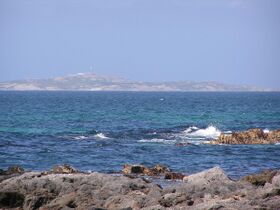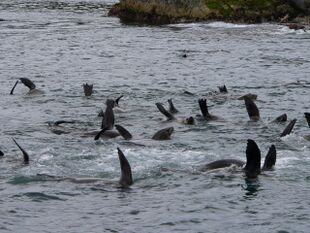Biology:Montague Island (Australia)
| Native name: Barunguba | |
|---|---|
 The island viewed from Narooma, 9 kilometres (5.6 mi) away | |
| Geography | |
| Location | Tasman Sea |
| Administration | |
Australia | |
| State | New South Wales |
| Montague Island Nature Reserve New South Wales | |
|---|---|
IUCN category IV (habitat/species management area) | |
 Australian fur seals located in the water adjacent to the island | |
| Script error: No such module "Australian place map". | |
| Nearest town or city | Narooma |
| Coordinates | [ ⚑ ] : 36°15′S 150°13′E / 36.25°S 150.217°E |
| Established | January 1990[1] |
| Area | 0.81 km2 (0.3 sq mi)[1] |
| Visitation | 6,000 (in 2002) |
| Managing authorities | NSW National Parks & Wildlife Service |
| Website | Montague Island Nature Reserve |
| See also | Protected areas of New South Wales |
Montague Island (Yuin: Barunguba) is a continental island contained within the Montague Island Nature Reserve, a protected nature reserve that is located offshore from the South Coast region of New South Wales, in eastern Australia . The nearest town located onshore from the 81-hectare (200-acre) reserve and island is Narooma, situated approximately 9 kilometres (5.6 mi) to the northwest.[2]
Montague Island is the second largest island off the New South Wales east coast after Lord Howe Island. It has been classified by the National Trust as a Landscape Conservation Area for its scenic, scientific and historical values. The Montague Island Light buildings are entered on the Register of the National Estate because of the architectural quality of the tower and residences.[2]
The island was first sighted by Europeans in 1770 by James Cook and named Cape Dromedary, then identified as an island and named by the master of the Second Fleet convict transport Surprize after George Montagu-Dunk, 2nd Earl of Halifax.[3][4]
Montague Island is a popular tourist destination, known for its lighthouse, wildlife, most especially little penguins (Eudyptula minor), and recreational activities; managed by the NSW National Parks & Wildlife Service (NPWS).[5] Public access to the island is restricted to guided tours conducted by the NPWS in association with private operators.[2]
Lighthouse
A lighthouse is maintained on the island by the Australian Maritime Safety Authority. The lighthouse was designed by James Barnet and built in 1881. It was automated in 1986 and demanned in 1987. The lighthouse is 21 metres (69 ft) tall and the light is 80 metres (260 ft) above sea level with a nominal range of 20 nautical miles (37 km; 23 mi) and a geographic range of 17 nautical miles (31 km; 20 mi). The original Fresnel lens was removed in 1986 and is now on display at the Narooma Lighthouse Museum.[6]
The next lighthouse to the north is the Burrewarra Point lighthouse. Amateur radio expeditions to the island were organised in 2010 and 2011.
Wildlife
Forty nine species of fauna have been recorded on the island by the New South Wales National Parks and Wildlife Service.[7]
Little penguins
The island is home to a large colony of little penguins on the island. As the island has no foxes or feral cats, the penguins have no predators other than other seabirds and seals. With the restoration of native habitat and the provision of penguin breeding boxes, penguin numbers have increased, and there are now approximately 12,000 on the island. The female usually lays two eggs, and during a good year, both chicks will survive. The birds come ashore at dusk after feeding at sea, and visitors to the island can watch the birds from a platform near the jetty.
Crested terns
Crested terns, Sterna bergii, have brilliant white feathers covering the body while the head is completely black.
Shearwaters
Shearwaters, also known as mutton birds, nest on the island. Species recorded are:
- Puffinus bulleri (Buller's shearwater)
- Puffinus griseus (sooty shearwater)
- Puffinus pacificus (wedge-tailed shearwater)
- Puffinus tenuirostris (short-tailed shearwater)
Seals
The northern tip of the island is the seasonal home to a seal bachelor colony. Due to the site's remoteness, it is only possible for visitors to see them from a boat.
The majority of the seals are Australian fur seals, (Arctocephalus pusillus doriferus), New Zealand fur seals (Arctocephalus forsteri), subantarctic fur seals (Arctocephalus tropicalis) and Australian sea lions (Neophoca cinerea) have also been observed.
Climate
Script error: No such module "weather box".
Environmental restoration
Kikuyu grass is a major weed on the island. Originally introduced in the early 19th century to help feed the animals kept by the lighthouse keepers and their families, it has spread to cover most of the south island. To control it, NPWS officers poison a section, then burn it, before replanting with help from volunteers. In the less accessible areas of the northern and eastern parts, an aerial spraying program is used to manage the kikuyu where it infests shearwater breeding sites. The kikuyu is a barrier for the shearwaters and penguins who cannot penetrate it to move or to burrow. Various native species are used to replant areas after the kikuyu grass has been controlled.
See also
- List of islands of New South Wales
- Protected areas of New South Wales
References
- ↑ 1.0 1.1 "Montague Island Nature Reserve: Park management". Office of Environment & Heritage. Government of New South Wales. http://www.environment.nsw.gov.au/NationalParks/parkManagement.aspx?id=N0596.
- ↑ 2.0 2.1 2.2 Montague Island Nature Reserve: Plan of management (PDF). Government of New South Wales. November 1995. ISBN 978-0-7310-0852-0. http://www.environment.nsw.gov.au/resources/parks/pomFinalMontague.pdf. Retrieved 30 September 2014.
- ↑ Flinders, Matthew (1814). A Voyage to Terra Australis. London: G. and W. Nicol., entry for 3 February 1798
- ↑ Reed, A. W. (1969). Place names of New South Wales, their origins and meanings. Sydney: Reed Books.
- ↑ "Adventure - Montague Island Nature Reserve". VisitNSW. Government of New South Wales. http://www.visitnsw.com/destinations/south-coast/batemans-bay-and-eurobodalla/adventure-montague-island-nature-reserve.
- ↑ Rowlett, Russ. "Lighthouses of Australia: New South Wales". The Lighthouse Directory. University of North Carolina at Chapel Hill. http://www.ibiblio.org/lighthouse/nsw.htm.
- ↑ (Wildlife atlas)
- ↑ "Climate Statistics for Montague Island Lighthouse". Climate statistics for Australian locations. Bureau of Meteorology. http://www.bom.gov.au/climate/averages/tables/cw_069017_All.shtml.
External links
| Wikivoyage has a travel guide for Montague Island. |
- Montague Island Nature Reserve: Plan of management (PDF). Government of New South Wales. November 1995. ISBN 978-0-7310-0852-0. http://www.environment.nsw.gov.au/resources/parks/pomFinalMontague.pdf.
- Montague Island Nature Reserve: Amendments to Plan of Management (PDF). Government of New South Wales. 30 July 2003. ISBN 978-0-7313-6625-5. http://www.environment.nsw.gov.au/resources/parks/pomfinalamendmentsMontagueIsland.pdf.
- Amendments to Montague Island Nature Reserve: Plan of management (PDF). Government of New South Wales. 17 December 2009. ISBN 978-1-74232-628-3. http://www.environment.nsw.gov.au/resources/parks/montaguepomfinal.pdf.
- Montague Island - Local and Tourist information
- Narooma - Local and Tourist information
- Montague Island - VisitNSW
 |

